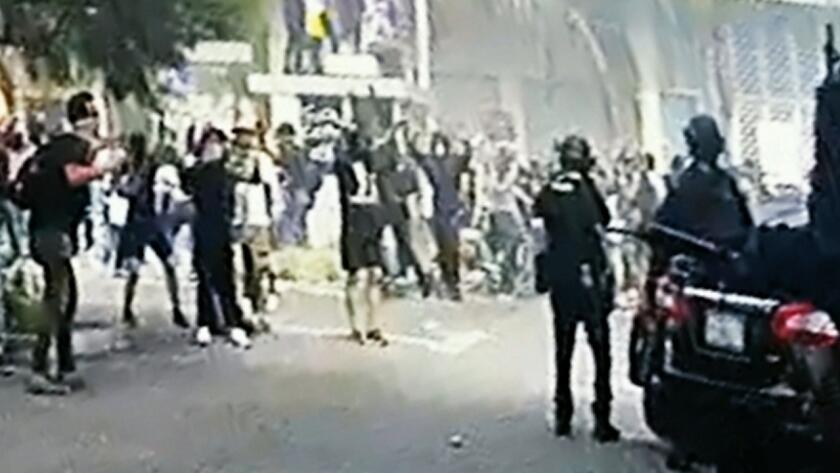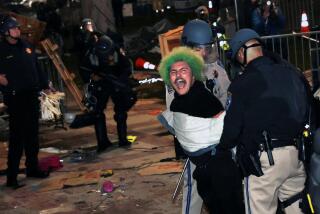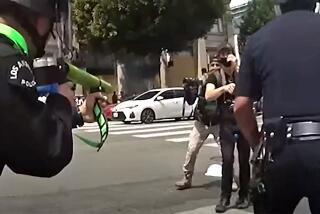One man’s fight to hold an LAPD officer accountable for a protest shooting
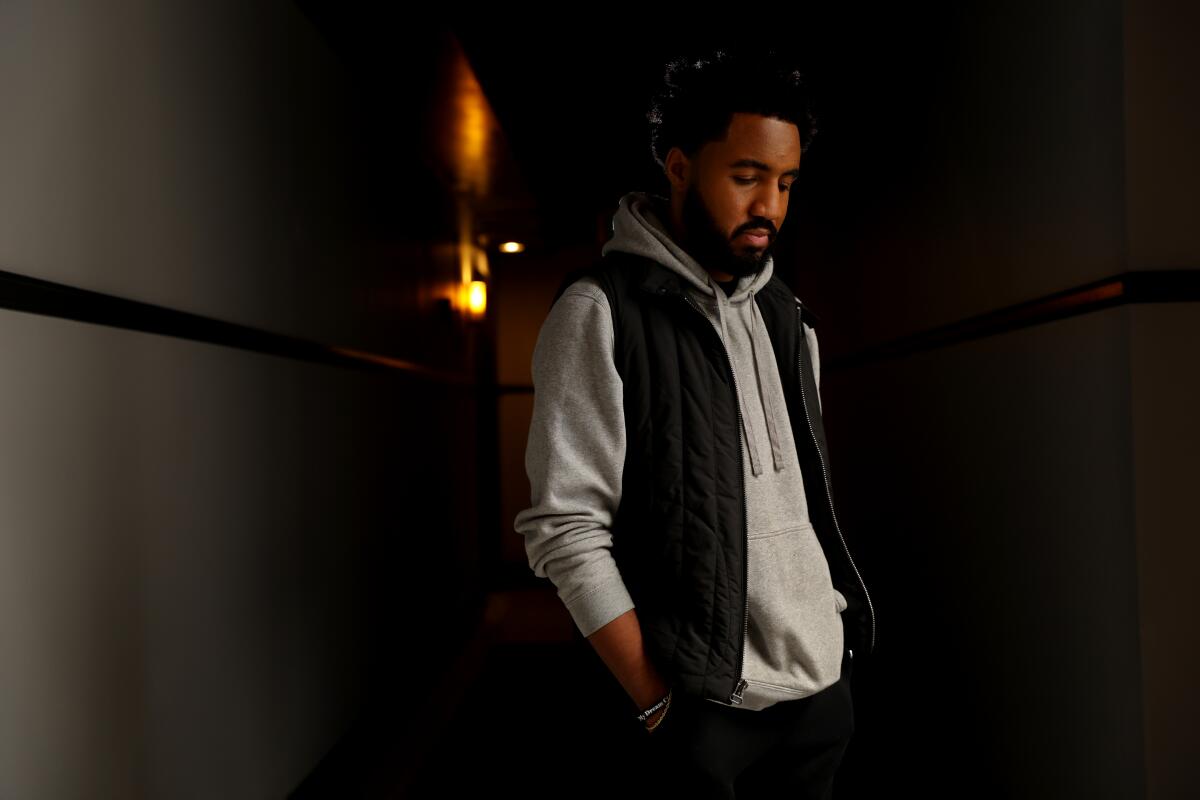
- Share via
Since Deon Jones first alleged that a Los Angeles police officer had unjustly shot him in the face with a hard-foam projectile at a 2020 protest, he and his legal team have gone to great lengths to prove it.
They fought for, obtained and scoured hours of police body-camera video to find instances of officers firing such weapons during L.A.’s mass demonstrations over George Floyd’s murder.
When they found the shot they believed struck Jones — fracturing bones in his face and ripping the skin from his cheek bone — they hired a forensic video analyst to retrace Jones’ movements that day and prove he was in the line of fire.
In several pixelated video frames, the analyst spotted Jones’ gray backward hat or the logo on the front of his jacket. He used those sightings to follow Jones through the chaos to the moment where he and other protesters were cornered in a Trader Joe’s parking lot and LAPD Officer Peter Bueno opened fire into the crowd.
- Share via
Attorneys for Deon Jones, who alleges he was unjustly shot in the face by a hard-foam projectile at a 2020 protest, hired a forensic video analyst to scour police body-camera video to prove Jones was in the line of fire.
Nearly three years after the protests sparked a mountain of complaints and litigation over the LAPD’s mismanaged and at times violent response, Jones’ civil case against Bueno is set to go to trial in federal court Tuesday. It showcases how difficult it has been for protesters to hold individual officers accountable for wounding them.
Despite tremendous amounts of police and bystander video, not every baton strike or projectile shooting was captured clearly.
Jones’ legal team conducted its own inquiry into the shooting after LAPD investigators found the available evidence inconclusive and cleared Bueno of wrongdoing. Among the evidence considered was blurry footage of the shooting from another officer’s body-camera video.
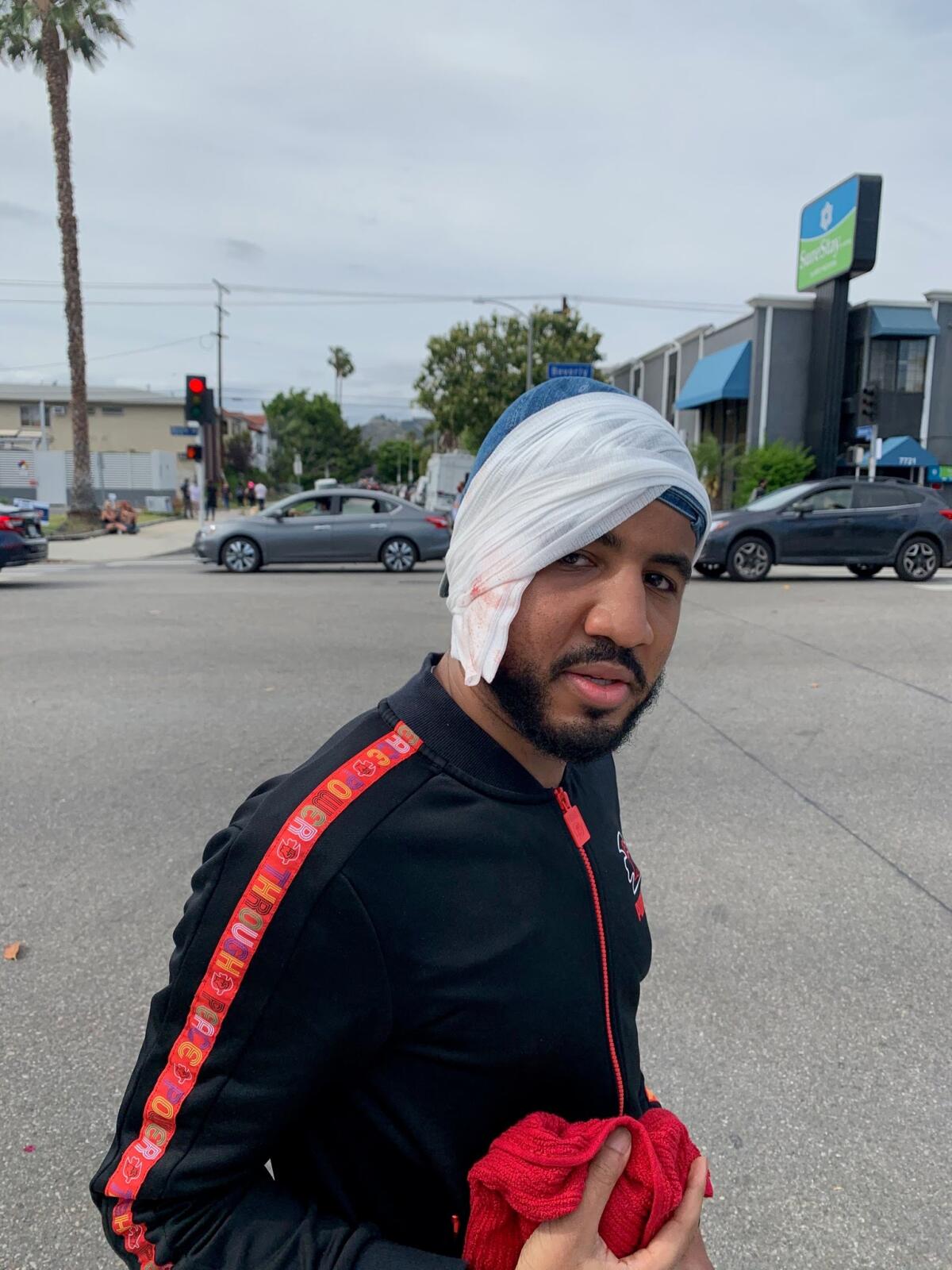
Bueno has denied shooting Jones. His attorney, Janine Jeffery, said she could not discuss the case before trial because doing so could taint the jury pool.
According to data provided to The Times, LAPD investigators have rejected all but about 2% of misconduct allegations out of the hundreds leveled against officers during and after the protests.
A half-dozen civil claims against officers have been settled before trial — costing taxpayers nearly $1.7 million to date — but always without admission of guilt or wrongdoing. A class-action lawsuit brought by Black Lives Matter Los Angeles and others remains pending, but it focuses more on the culpability of the city and the LAPD than on individual officers.
Jones, 31, who has a background in civil rights work and the backing of a pro bono legal team, has refused to take a settlement. His team has driven his case to trial with the goal of holding Bueno responsible for shooting him and, in his view, violating his constitutional rights.
The looming trial promises to strike at the heart of a debate that has raged in L.A. for decades:
When the LAPD finds itself in the middle of a mass protest, where does the line fall between legitimate crowd control and excessive force? And if an individual officer can be shown to have crossed that line, what happens then?
Competing investigations
Less than two weeks after the massive May 30, 2020, protest in the Fairfax district where Jones was wounded, The Times published an article outlining his and other protesters’ claims that police had beaten them with batons and shot them with projectiles without justification.
“We are protesting police brutality and then being brutalized by police while we’re protesting,” Jones said at the time.
Based on the article, the LAPD began an investigation. Jones filed his lawsuit in December 2020, alleging he was unjustly struck with a baton and shot with a projectile. In his complaint, he included pictures from the hospital of his swollen, stitched-up face.
Over the next year, the LAPD and Jones’ legal team conducted parallel investigations.
In March 2021, a judge ordered the parties to figure out the identity of the officer who Jones alleged shot him. Jones’ attorneys requested all documents from the internal investigation and asked for any video recordings in the city’s possession that concerned Jones or any of the LAPD’s responses to the major protests that day — including all video of projectiles being fired.
The city took eight months to produce that video in its entirety, according to court records. But by May 2021, Jones’ attorneys had a good amount of footage and advised the court that they identified Bueno as the officer they believed shot Jones.
According to records filed in the case, the LAPD had also zeroed in on Bueno but stopped short of concluding he shot Jones.
According to the LAPD Force Investigation Division’s final report, Jones’ friend Niara Hill — who was with him that day — told investigators he had been shot by an officer from about 20 feet away while standing in a crowd outside of the Trader Joe’s near 3rd Street and Fairfax Avenue.
Hill said he ran before collapsing and that she and other protesters tended to him in the street before he went to urgent care and then Cedars-Sinai Medical Center. Hill also pointed out on a map where the shooting had occurred.
Hill said the shooting happened after she and Jones saw a police car on fire and decided to leave for the day, but before a fire engine had arrived at the scene. Police investigators determined that meant the shooting had to have occurred between 3:19 p.m. and 3:33 p.m., and they focused their review of body-worn video of officers who were near the Trader Joe’s during those 24 minutes.
Based on that recording, the investigators determined that Bueno was the only LAPD officer to fire a 40-mm projectile launcher in that location at that time. They found he did so three times, including in response to unidentified protesters throwing bottles at officers. The investigators also said they were able to identify Jones and Hill in the same area in the minutes before Bueno opened fire — and that Jones did not appear to be injured.
Despite that, along with the direct accounts of Jones and Hill and Jones’ corroborating medical records, the LAPD investigators determined they couldn’t prove Bueno shot Jones.
Although the body cameras of four other officers “captured Bueno’s positioning with the less lethal launcher, the audible discharge of the less lethal launcher, and various perspectives of the crowd throwing objects” that prompted him to open fire, “none of the [body-worn video] captured Jones being struck by an officer’s baton or a less lethal munition,” the LAPD’s final report said.
The investigators wrote that Jones was wearing a COVID-19 face mask, and that his face couldn’t be seen in the poor-quality video that was available, so they were “unable to determine if Jones had an injury to his face prior to the alleged use of force.” That was despite their finding that Jones had appeared unhurt just minutes before.
The LAPD investigators interviewed Bueno, who told them he didn’t recall shooting anyone in that area — testimony he would contradict during a deposition in the court case. He also told them he believed the sling of his projectile launcher had accidentally powered off his body-camera.
According to the report, top brass agreed to close the investigation in May 2021, and Chief Michel Moore agreed a month later.
Jones’ attorneys weren’t given a copy of the full report until October 2021. Five months after that, their own video analyst, Jason Latham, provided his forensic report.
According to court records, Latham spent more than 40 hours reviewing and enhancing the available video from that day. He will testify that Jones was in the crowd that Bueno fired toward and that Jones can be seen rushing from the area immediately after the shot.
17 out of 833
In the aftermath of the protests, amid the lawsuits and online videos of officers wielding batons and projectile weapons, city and LAPD leaders acknowledged missteps and promised improvements.
Three reviews of the LAPD’s handling of the protests were conducted, with each finding failures in leadership and lapses in training, particularly when it came to the use of projectile launchers. The LAPD tightened its rules for the weapons, in part under orders from a federal judge.
However, discipline for individual officers accused of misusing the weapons has been almost nonexistent.
According to a review of LAPD data by The Times, the department’s decision to close its investigation into Jones’ shooting without disciplining any officer fits within a broader pattern of officers avoiding serious discipline or receiving none in cases where protesters were injured.
Out of 833 distinct allegations of misconduct made against officers from the 2020 protests, 17 — or about 2% — were “sustained” by the department, meaning the LAPD found them to be true and sought to discipline officers accordingly.
Of those 17, three were related to unauthorized force being used, despite hundreds of allegations from protesters of excessive and illegitimate force. In those three cases, officers received a “reprimand” or an “admonishment.” None was suspended or faced any more serious punishment.
The department would not provide descriptions of those three incidents, citing officer privacy, and did not immediately respond to a public records request filed by The Times for related reports or documentation.
The harshest punishment received by any officer for actions taken during the 2020 protests, according to the LAPD’s data, was a three-day suspension related to an unspecified violation of body-worn or in-car camera policies.
The department most frequently concluded that the allegations were unfounded, which it did in 365 cases. Its second most frequent determination was that there was “insufficient evidence” to prove the assertions in 232 incidents out of the 833.
The LAPD has a years-long history of dismissing every complaint it receives of officers showing racial or other biases At the peak of the COVID-19 pandemic, it rarely disciplined officers who broke rules requiring them to wear masks. And it has a history of not seriously disciplining officers found to have broken department rules during police shootings.
When department leaders issue stiff penalties for officer misconduct, civilian discipline panels often reduce the punishments.
The LAPD said in a statement that it “stands by the integrity of the investigations” it conducted into protest complaints and that “appropriate action was taken” when officers were found to have broken policy. It declined to comment on Jones’ case, as did the city attorney’s office.
Jones, who also declined to comment for this article, has said his goal in suing the city and Bueno was not just to win a settlement for himself but to confront the lack of accountability within the department — particularly around the misuse of projectile weapons.
“My intention is to put an end to LAPD’s use of rubber bullets,” Jones said in a 2020 interview with The Times, using a colloquial term for the projectiles that officers use. “We have a constitutional right to peacefully protest, and nobody should be afraid that their decision to protest peacefully will land them injured or dead.”
Heading to trial
The trial in Jones’ case against Bueno is set to begin Tuesday in federal court in Santa Ana. The portions of his case against the city and the LAPD will be heard later.
It remains unclear how a federal jury of people from the greater L.A. region might perceive evidence in the case and whether they will find that it implicates Bueno. They will have an extraordinary window into the 2020 protests and the actions of LAPD officers who responded.
District Judge Fred W. Slaughter, who works out of Santa Ana and is presiding over the case, has ruled that the LAPD’s investigative report into the shooting cannot be admitted as evidence, nor can the three formal reviews of the LAPD’s handling of the protests.
However, Slaughter did allow a trove of body-camera video from that day to be admitted — video Jones’ attorneys fought to have unsealed, some of which has never been seen publicly before.
The video shows officers on skirmish lines hitting protesters with batons and shooting them with projectiles. In one, a supervisor tells an officer to shoot a protester directly in the chest at close range. In another, an officer grabs a protester from behind and throws the person to the ground. In a third, officers swing their batons wildly at protesters — including a man who is on the ground.
At least 10 videos show Bueno firing his projectile weapon, which court records suggest he did more than two dozen times. The videos show him aiming his weapon at head and chest level of nearby protesters, firing into crowds at a distance and shooting at someone on a rooftop — which he was later told not to do. The video shows Bueno was concerned about objects being thrown at officers, including water bottles.
Under LAPD policy, officers can shoot 40-mm projectiles only at specific people who represent a threat to officers or others and are to aim at the abdomen — never at the head.
Bueno prepared handwritten notes after the protest indicating he fired his weapon 25 times, according to court records. Investigators determined he fired at least three more times in the Trader Joe’s parking lot, which he hadn’t included in his notes.
Jones’ attorneys have said Bueno fired far more than other officers with projectile weapons, and that the true total is unknowable because his body-camera was turned off for much of the day.
While Bueno initially told investigators he didn’t recall shooting anyone in the area near the Trader Joe’s, he later testified during a deposition that he did recall firing his weapon there. He said he specifically recalled shooting a protester who had just thrown a plastic water bottle in his direction.
Bueno said he fired because he believed the protester represented an imminent threat to officers and that he saw the projectile strike the protester in the abdomen. Such a shooting would be justified under LAPD policy.
According to a court filing, Jones will tell the jury he believed he was going to die that day and is still emotionally triggered by loud noises, news about police violence toward Black people and other things that remind him of being shot.
“He continues to have dreams, recurring nightmares and flashbacks about being shot in the face,” the court filing says, “causing him to feel as though he is reliving the trauma.”
He still fears going to protests — a fear he says the LAPD should not be allowed to instill in anyone.
More to Read
Sign up for Essential California
The most important California stories and recommendations in your inbox every morning.
You may occasionally receive promotional content from the Los Angeles Times.
